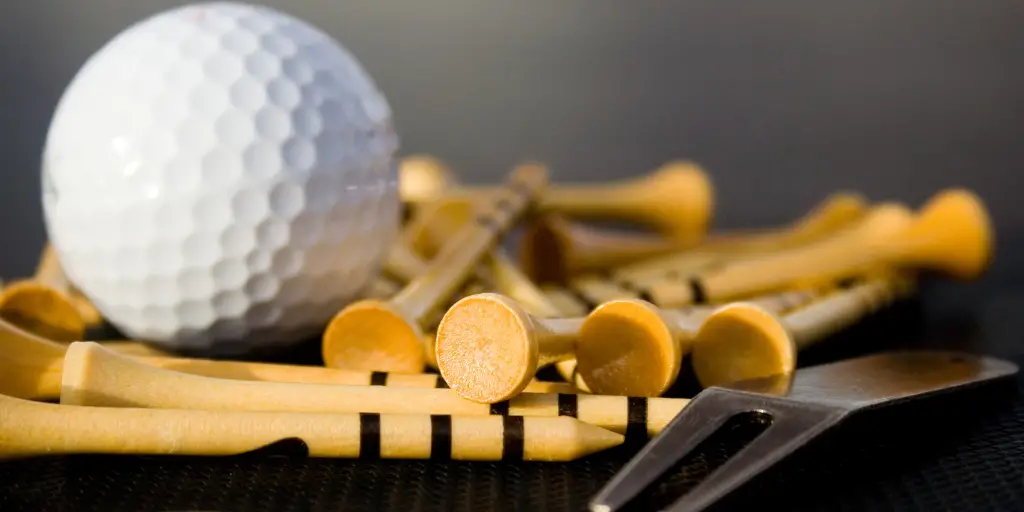Just like any sport, the game of golf has some very interesting and possibly confusing terms. Especially if you are just starting out or if you have never had anyone teach you some of the golf specific language out there, this list will come in very handy. Some of the vocabulary that you will learn here could save you from an embarrassing situation or help you understand what the people you are playing with are saying.
Scoring Vocabulary

The first thing that every golfer needs to know are the commonly used “scoring” terms that you hear out on the course. These words describe everything from how many strokes you need to write on your scorecard to the terminology that you will hear when you do something great or something terrible.
Par: The number of strokes that a golfer should need to complete a hole. Every hole on a golf course is rated either a par-3, par-4, or par-5. Anything below that number adds to your score in tournament play and anything below that number subtracts from it.
Bogey: When you make 1 stroke above par. For instance, if it takes you 5 shots to get the ball in the hole on a par 4, you have just bogeyed that hole. For many golfers, this is a more than respectable score.
Double Bogey: When you make 2 strokes above par. You can probably figure out what a triple bogey and above would be called based on this. Another term you do not every want to hear would be “double par” which would be if you scored an 8 on a par-4.
Birdie: When you score one under par on a hole.
Eagle: When you score 2 under par on a hole. Most eagles will occur on a par-5 or a short par-4.
Albatross (Double Eagle): It is called an albatross because of how rare it is. This is when you score 3 strokes below par on a hole, either a hole-in-one on a par-4 or holing out on the second shot of a par-5.
Green in Regulation (GIR): This is your goal on every hole. To reach a green in regulation means that you are at least putting for birdie on that hole. Your ball must be on the green in either 1 shot on a par-3, 2 on a par-4, or 3 on a par-5. You definitely want to make this a part of your golfing vocabulary as soon as possible.
Up and Down: Getting up and down is making par without reaching the green in regulation. For instance, if you hit your approach shot in the rough but are able to chip the ball close to the hole and tap it in, you got “up and down” on that hole.
Snowman: This is a term that you need to know, but hopefully you will not have to experience it too often. A snowman is when you score “8” on a hole.
Hole-in-One (Ace): Hopefully you already know what this term means, but it is when your tee shot ends up in the hole. This should be accompanied by celebration and your golfing buddies taking you out after the round.
Handicap: A system used to rate a golfer based on the average number of shots they play in comparison to par. If you are a 10 handicap, then your average score is 82 on a par-72 course.
Types of Shots

These are the basic shots that you will take out on the course. Most of these depend on the distance you are from the hole or the type of arc you need to put on the ball so that it sticks next to the pin.
Drive: A long tee shot played with a wood or a driver.
Chip: A short shot from around the green that is almost like a long putt.
Putt: A shot played on the green where the ball, traditionally, stays on the ground and is rolled toward the hole. Improving your putting is the best way to improve your score.
Draw: A right to left ball flight for right handed players. As opposed to a hook, this is a very controlled ball flight that promotes roll and accuracy.
Hook: A right to left ball flight that is not controlled and usually ends up in the rough or the trees.
Fade: Also known as a “cut shot” this is a left to right ball flight for right-handed players that is as controlled as a draw.
Slice: A left to right ball flight that is similar to a hook but is much more common in beginning players.
Approach: The shot taken from the fairway to the green. Unfortunately for many of us, we can have multiple approach shots per hole if we mishit or shank our first few.
Flop: A shot played around the green where you open up the face of your club and try to get the ball high so that it lands softly on the green. It is a thing of beauty when you pull it off, but it has a high degree of difficulty.
Shank: When you hit the ball with the rounded hosel of your club rather than the face. This almost inevitably sends your ball directly to the right and is one of the most embarrassing things you can do in golf. You may be familiar with the “Shank” scene in Tin Cup which is a perfect explanation of the term.
Clubs

Iron: The metal clubs in your bag usually numbered 4 to 9 (sometimes people will carry lower irons, but not as often anymore). Usually the lower the number the farther it will travel and the higher the number the higher the trajectory will be.
Driver: The longest and biggest club in your bag. You will only hit this club about 10-12 times per round, but it is usually the most expensive and most technologically advanced club you will find.
Wood: These clubs produce the most distance from the tee, starting with your driver, or off of the ground. They get their name because early woods actually had wooden heads.
Hybrid: They are called hybrids because they are a combination of a long iron and a high-lofted wood. They are easier to hit than a long iron and get off the ground better than a wood so many high handicap players use them. However, the more technology continues to improve, the more hybrids you are seeing in any bag.
Wedge: The high lofted clubs including but not limited to a sand wedge, a pitching wedge, and a gap wedge. These clubs are used for touch as you get close to the green.
Putter: A flatter edge club that is used to roll the ball on the green. There are many shapes and sizes so it is important to choose the right one for your game.
Driving Iron: A low lofted iron that’s part hybrid, part long iron
Texas Wedge: When you use your putter from anywhere off of the green.
On the Course

Fore: Shout this word when you send a ball flying toward an unsuspecting group of golfers either in front of you, or if it is a really bad shot on the hole next to you, so that they know to take cover.
Dog Leg: A term referring to the architecture of the course. A dogleg right or left refers to a straight fairway that is followed by an abrupt turn one way or the other. The ability to hit a fade or a draw comes in handy on these holes.
Mulligan: An unofficial do-over of sorts. It is when your shot is so bad that you just drop another ball and hit it again. Many times the people you are playing with will give you 1 or 2 a round with not penalty, but this is definitely not an official rule of golf.
Fairway: The shorter grass between the tee box and the green generally found in the middle of a golf course. If you can keep your ball on the fairway, you almost always have a good lie and you are generally set up nicely for an approach shot.
Rough: When you miss the fairway, the rough is the longer grass in between the hole boundary line and the fairway. Because of the length of the grass, you could find yourself with a good or bad lie, but it is generally more difficult to hit out of the rough than the fairway.
Flag: Used to mark holes on the golf course.
Green: The specially prepared and manicured grass surface surrounding the hole. Greens can be fast or slow, soft or firm, and easy or difficult depending on the course and the weather.
Gimme: When your putt, chip, or approach is close enough to the hole that your playing partners do not make you finish the hole out. Anything beyond 2 feet should be putted in, but it really depends on who you are playing with.
Divot: The hopefully small piece of turf that comes up with when your club head makes contact with the ground. Divots are normal and natural, but replacing your divots is very important, especially the larger ones.
Playing the Tips: A term referring to a golfer’s decision to play from the tee boxes that are the farthest from the hole. This is not recommended for beginners because playing longer also gives you different angles and hazards.
Away: Refers to the player whose turn it is to hit next because he is the farthest away from the hole. This is golf etiquette and is the reason that having something to mark you ball on the green is always important.
The Turn: The halfway point in a round of golf.
Duff: A bad shot.
Bunker (Beach): Sand bunkers are used on many courses as additional hazards. These bunkers are generally cut out of the course and filled with sand so that it is more difficult to hit your ball. Sand wedges are commonly used on greenside bunkers.
Hazard: Anything on a golf course that is designed to make scoring more difficult. Water and sand are perfect examples of hazards on the course.
Sandbagging: When a golfer claims he is much worse at golf than he actually is. If you are playing in a tournament based on handicap, sandbagging your handicap is frowned upon.
Types of Games

Best Ball: This is a type of game usually reserved for tournament play where a group of 2 or more golfers play together on a team. Each golfer hits a shot and whoever’s shot is the best is used. Best ball matches usually produce the lowest scores.
Scramble: A scramble is similar to the best ball format, but generally there are only 2 players and usually it is required to take a certain percentage of shots from each player. In some scrambles, golfers take turns hitting the ball so that 2 players play like one.
Match Play: Match play is a 1-on-1 format in golf. Rather than taking an overall score, players compete against each other hole after hole and whoever wins a hole gets a point for that hole. The goal of this style of play is to simply win the most holes.











